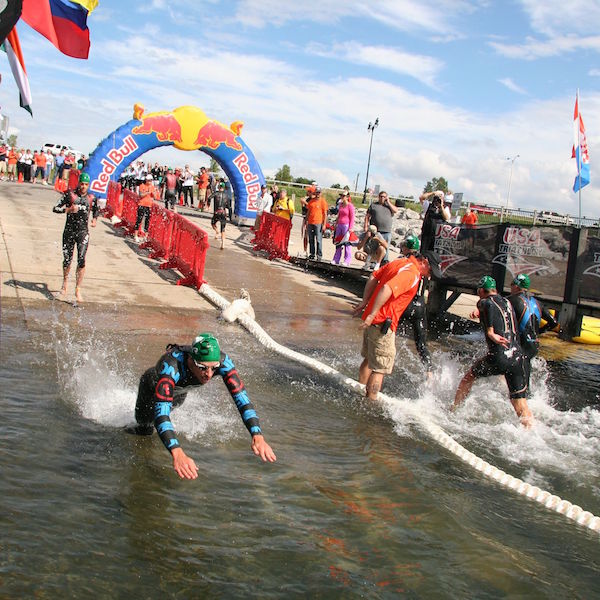Race season is upon us. The weather is warm and so is the water. Time to transfer your pool skills and fitness to the race venue. Swim training at the local pond or beach improves race times, increases confidence and brings a change of pace to the monotony of endless laps in the pool.
Safety First
In the “wild” environment of the open water, always take a few minutes to familiarize yourself with your surroundings: Are there any obstacles to the entry/exit? What is the water temperature? Will you need a wetsuit? What are the currents, riptides, waves, chop, etc. Then once you’re in, practice your in water safety skills: treading water, breathing when the cold water takes your breath away, floating on your back, and using an alternate resting stroke. Get into a comfortable rhythm of breathing as part of your warm up. If you’re new to open water or have some fear, there is a new device called the Safe Swimmer Float. It’s a lightweight inflatable bright orange buoy that floats behind you while swimming and can be used as a flotation device in emergencies.
Sighting and Navigation
With no black line to follow, no walls and lane lines to guide you, sighting and navigation present a new challenge at your local open water venue. First, a goggle check: do they leak, fog up, do you spend a lot of time messing with them? Get a pair of goggles that fit properly, stay in place and use the anti-fog solution before entering the water. These simple acts will help decrease any sense of disorientation that often occurs while in the open water. Good navigation starts with clear vision.
Swimming straight is another challenge. Improvement here begins with the best, most symmetrical stroke you can produce. During your warm up, swim some of the drills you practice in the pool. This will help you focus on good stroke mechanics right from the start. Try the swim straight drill to determine how straight you swim and if you tend to veer off in one direction. Swimming straight means faster times and greater efficiency while in the water.
Once you’ve determined how straight you swim, next comes how to sight and how often. While standing at the shore, it is quite easy to see where you’re planning to go and the landmarks or buoys you’re aiming for. But, down at water level with your head only inches from the surface, these markers can suddenly disappear. Take the time to get in the water and look for your markers. They often need to be bigger and higher than you planned. If you’re swimming straight into the sun, consider this variable as it can be blinding. Tinted or mirrored goggles can help in this situation. If you’re not swimming straight, practice sight breathing more frequently, every 3-5 strokes. Once you’ve learned to swim straighter, sight less frequently, every 6-10 strokes. Drills: polo drill and sight breathing.
Swimming in a group
Leave the peace and comfort of having your own lane at the pool. Take advantage of the opportunity to swim with a group of your friends or competitors. Swimming in a group can be both terrifying and exhilarating. To be more comfortable with this aspect of racing, get a group of your friends or tri club members together and practice mass starts. The accidental kicking and punching will become more routine and you can learn to exploit the group or avoid the washing machine altogether. After you’ve done a few mass starts, practice rounding the buoys individually and in the group. There is a technique to making turns in the open water and avoiding the carnage that can occur at the first turn buoy. Consider entering a few local open water swim races or aquathlons to gain valuable race experience.
Start/Finish
How you approach the start of the race is a function of your swim fitness and experience racing in the open water. If you’re a good swimmer, start at the front and get out fast. Practice this by working on your start speed. Everyone can improve their times and skills by working on their start speed. Train in the open water at your goal race pace or perceived exertion of that pace. (Remember how it felt in the pool.) In order to finish strong, practice your finish speed, exit run and wetsuit strip.
How often do you do a run right after your swim workout? Even with the new barefoot running craze, do you run barefoot right after your swims? While swimming, your feet are in the dorsi-flexed position stressing your calves and ankles. Standing up to suddenly run barefoot can cause calf cramping or other foot issues. If you struggle through the T1 run, do a short run either right out of the open water or just after your pool workouts 1-2 times/week.
Dives and dolphin dives
Keeping your goggles in place at the start involves knowing how to dive. First, put your goggle strap under your bathing cap to help your goggles stay put. Next practice shallow dives from the beach or in the pool. Dolphin dives are a great skill for moving faster in thigh deep water. They require practice and use more energy, but can give you an advantage where there is a long, shallow start or finish.
A long endurance swim is the most common and a very important aspect of open water swim training. For a more enjoyable and faster open water swim, follow some of the drills and workouts that supplement this article. You will be pleased with how much fun open water swimming can be. When you do your homework, race day results speak for themselves.
Part 2 of this blog will give you some great open water swim workouts to execute giving you a competitive edge on race day.
